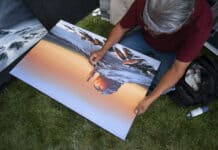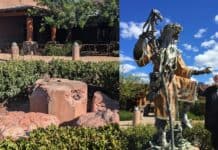Primary colors spatter the glossy bedroom eyes of pop icon Marilyn Monroe. Her seductive, half-lidded stare and luscious ruby lips angle up as if to kiss the viewer.
Glamorous and tragic, Monroe’s double life, one for public consumption, the other, confused, chaotic and hidden from view, emerges from a canvas saturated by the bright, brilliant hues of master pop artist James Gill.
Gill’s work hangs at the great galleries of the nation, including the Whitney Museum of American Art, the Smithsonian American Art Museum, among others, and now, after decades away from the art scene, Sedona’s Lanning Gallery.
By Greg Ruland
Larson Newspapers
Primary colors spatter the glossy bedroom eyes of pop icon Marilyn Monroe. Her seductive, half-lidded stare and luscious ruby lips angle up as if to kiss the viewer.
Glamorous and tragic, Monroe’s double life, one for public consumption, the other, confused, chaotic and hidden from view, emerges from a canvas saturated by the bright, brilliant hues of master pop artist James Gill.
Gill’s work hangs at the great galleries of the nation, including the Whitney Museum of American Art, the Smithsonian American Art Museum, among others, and now, after decades away from the art scene, Sedona’s Lanning Gallery.
Gill knows something about living two lives. Decades ago, at the peak of his popularity, the artist left a lucrative life of celebrity behind in Los Angeles.
His light burned bright when critical acclaim prompted Time Magazine to hire him to paint a portrait of Alexander Solzhenitsen, the exiled Russian dissident, for its Sept. 27, 1968, cover.
“I was pretty hot market-wise at that time,” he said. “I was making enough money to get along and everything,” Gill said, his gentle Texas drawl mastering the understatement.
By the winter of 1972, however, life in the fast lane left a lot to be desired.
Some say it was the drugs rampant in the 1960s. Others says it was a certain creative anguish. Still others say the artist left the world of high art behind to search for inner peace along the California/Oregon border.
The truth is a little more mundane. “The University of Oregon asked me to teach art with them for a semester as a guest artist,” Gill said. The natural beauty of the Northwest called to him, but when the university offered tenure, he demurred.
“Really, I feel like the academic side of art can be death to an artist, so I turned it down, but came up north to live,” he said.
Gill sold everything he owned and headed north on Highway 101, searching for a place to reside, eventually landing in a spot called Whale Gulch along the California/Oregon border.
He bought equipment to move dirt, build roads, mill trees, everything necessary to construct a cabin from the ground up.
He spent the next several years living a simple life next to the Willamette River, first teaching at the university, then designing buildings in league with professional architects. He was among the first in the country to make use of the computerized design software, Auto-CAD.
Whale Gulch was a not a commune, per se, Gill said, but a small community eventually grew up around him.
“There was just a little homestead,” he said. “People got permission to build on other people’s land. People built their houses out of whatever they could come up with. It was a creative thing — getting your house together, getting a garden in, raising food and trying to make a living.”
The community met once a week to discuss matters of importance to the group. Some homesteaders grew marijuana in secret locations in the forest.
“There were dangerous elements to it,” Gill said.
Eventually, he burned out on the computer, but the creative artist inside him called him back to work.
“I got to where I couldn’t do [Auto-CAD] anymore, so I started painting with watercolors.”
It was 15 more years before an “unforgiving art world” decided to allow Gill back in, explained Gill’s wife, Ann.
His first showing since the heady days of 1972 took place in 2005, a retrospective of his work that exhibited in San Angelo, Texas, not far from Tahoka, the place of his birth.
Gill’s Arizona debut at Lanning Gallery marks his full-blown
re-entry into the world of high art.
[Editor’s note: Coming Wednesday, Nov. 5, Gill reflects on pop art, Andy Warhol and what makes a great artist.]





















